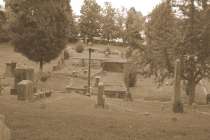
Since the Civil War, the 13-acre Old Gray Cemetery has been the final resting place for Union and Confederate veterans. During the conflict, control of Knoxville shifted from Confederate to Union forces, so it is appropriate that both sides are represented here.
Since the Civil War, the 13-acre Old Gray Cemetery has been the final resting place for Union and Confederate veterans. During the war, control of Knoxville shifted from Confederate to Union forces, so it is appropriate that both sides are represented here. The cemetery was established in 1850 and reflects the Rural Cemetery Movement that swept the urban South in the decade before the war.
There are no political divisions within Old Gray. Tennessee’s Reconstruction-era governor William G. “Parson” Brownlow (1805–77) lies buried just across the way from Henry M. Ashby (1836–68), one of the Confederacy’s youngest colonels. William Richard Caswell (1809–62), a brigadier general in the Provisional Army of Tennessee, was murdered at his Knox County home in 1862. U.S. Congressman Leonidas C. Houk (1836–91) organized the 1st Tennessee Infantry (USA), while U.S. Congressman Horace Maynard (1814–82) was one of the leaders of the 1861 Unionist Convention at Greeneville.
Ellen Renshaw House Fletcher (1841–1907) called herself “a very violent rebel” and kept an invaluable diary of life in Knoxville during the Civil War.
The Horne Monument features an almost life-sized sculpture of a Confederate soldier to mark the graves of William A. Horne (1845–91) and his brother John F. Horne (1843–1906). Union cavalrymen known as Gen. George Stoneman’s “Cossacks,” members of “The Immortal Six Hundred,” Confederate nurse Jennie Gammon (shot during the Battle of Fort Sanders), and Union caregiver Maggie S.P. Haynes (matron of the Union army’s Asylum General Hospital)—Unionists and Confederates alike are now peacefully at rest here.
“Next day we moved our camp to a grove opposite the Gray Cemetery…We had a beautiful situation here for a camp, in a pine and cedar grove, the ground softly carpeted with pine straw…While here we increased our battery to four guns…For a few weeks we had a hard time of it drilling new recruits. I got sick of giving the command, ‘Load by detail, Load!’.”
Tools
Key Facts
- Union and Confederate veterans buried together in Old Gray Cemetery
- No political divisions within cemetery.
- Reconstruction-era Governor William G. Brownlow is buried here.



